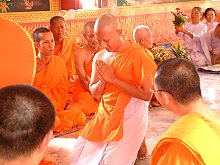Present Day
By the middle of the nineteenth century, Buddhism in Thailand had generally become corrupted with lax monastic discipline, teachings straying from the original texts, little emphasis on meditation, and a widespread belief that spiritual accomplishments were no longer possible.
In the midst of this waning tradition, determined Buddhist practitioners returned again to the basics of forest living, moral discipline, and meditation in search of the Buddha’s path to enlightenment.
The spiritual determination and accomplishments of these forest practitioners led to the emergence of the contemporary Forest tradition in North-east Thailand.
The North-east is one of the most remote and poor areas in Thailand, notable both for its harsh land and its remarkably good-humored people; and more recently for its wise meditation masters.
The emergence of the contemporary Forest tradition is associated largely with Ajahn Mun and his teacher, Ajahn Sao. Both were the sons of peasant farmers in the northeast of Thailand.
Ajahn Mun was born in the 1870s in Ubon province near the borders of Laos and Cambodia.
He trained under the forest monk Ajahn Sao, vigorously practicing meditation, and then turned to a life of ascetic wandering and meditation practice in the wilderness.
Ajahn Mun became a great teacher and exemplar of high standards of conduct.
Almost all of the accomplished and revered meditation masters of twentieth century Thailand were either his direct disciples or influenced by him. One of these great meditation masters following in his example was Ajahn Chah.
